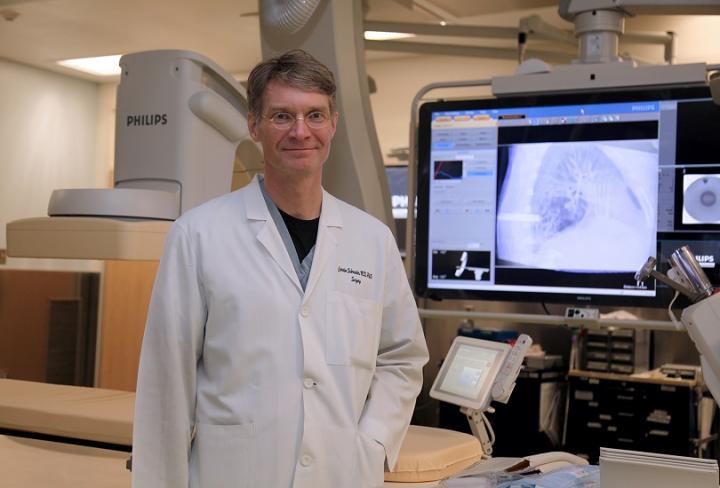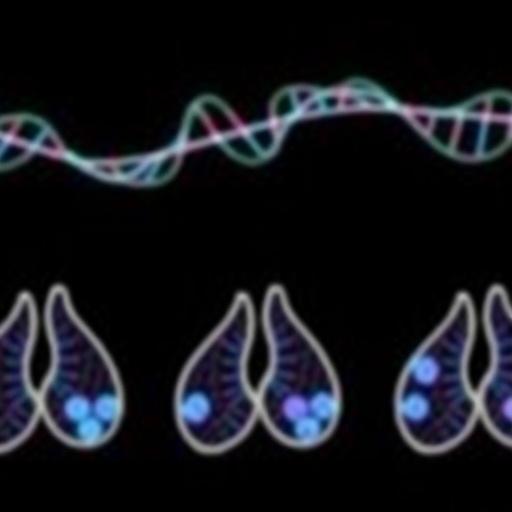
Credit: Phil Jones, Senior Photographer, Augusta University
Augusta, Ga. (Jan. 24, 2019) – A free, simple screening for lung cancer can save a patient money, while building a healthy relationship for any medical needs they may have in the future. The research, published in the Annals of Thoracic Surgery, shows the partnership can be beneficial for patients looking for cardiology specialists, family medical care and other health-related issues, as well as for medical facilities that offer the free screening.
“Our mission is to find lung cancer earlier,” said Dr. Carsten Schroeder, thoracic surgical oncologist at the Georgia Cancer Center and Medical College of Georgia at Augusta University. “If we find a nodule in the lung that’s in the later stages, survival rate is much worse than if we find it earlier.”
In the paper, titled “Financial analysis of free lung cancer screening shows profitability using broader NCCN Guidelines,” Schroeder and his team analyzed fiscal years 2015-17 to evaluate indirect cost, direct cost and adjusted net margin per case after factoring downstream revenue from treating patients with positive scans and other findings.
“In all, we have 1,600 people on the screening list,” Schroeder said. “Of those, 1,200 have actually had a scan. In just over 2 percent of those patients, we found lung cancer. The remaining 400 people do not meet the necessary criteria.”
The idea to develop the free lung screen program started after a major research paper was published in the summer of 2011. The National Cancer Institute’s National Lung Screening Trial, which included 50,000 people, showed a computerized tomography (CT) screening is better than chest x-ray for screening for lung cancer.
“There was a 20 percent increase in the survival rate for those patients who had the CT screening,” Schroeder said. “This paper was the one that served as a catalyst for the Centers for Medicare and Medicaid Services to start covering the cost of the screening for patients.”
While patients do not need to have health insurance to qualify for the lung screening program, there are some criteria they must meet, including:
Group 1:
- 55-75 years old.
- Currently a smoker or have quit within the past 15
years. - Smoked at least a pack of cigarettes a day for 30+
years.
Group 2:
- 50-75 years old.
- Smoked at least a pack of cigarettes a day for 20+
years. - Have at least one of the following additional lung
cancer risks:- Personal cancer history (lung, head and neck,
lymphoma). - Family history — parent, sibling or child — of lung
cancer. - Emphysema or chronic bronchitis.
- Chronic Obstructive Pulmonary Disease (COPD).
- Long-term exposure to asbestos.
- Asbestos-related lung disease or pulmonary asbestosis.
- Long term exposure to silica, cadmium, arsenic,
beryllium, chromium, diesel fumes, nickel, radon,
uranium or coal smoke and soot.
- Personal cancer history (lung, head and neck,
For his research, Schroeder and his team looked at the costs from a total of 705 scans. Of that 705, 418 patients were referred for follow-up procedures and specialist evaluations. The adjusted net margin per case was -$212 in the first year but turned positive to $177 in the third fiscal year.
One major factor influencing the profitability of a free screening, is the ability to use the National Comprehensive Cancer Network (NCCN) guidelines, which covers Group 2 of eligible patients. Currently, no other hospitals or medical centers in Augusta’s River Region can use NCCN guidelines because they charge patients for a lung screening. Using the NCCN guidelines allowed Schroeder and his team to detect twice the number of lung cancers than if they had only screened Group 1.
“Our free lung screening program is a win for the communities we serve and for the hospital system,” Schroeder said. “We bring them in for a free screening, which serves as a starting point for their medical care and health needs for the rest of their lives.”
###
Media Contact
Chris Curry
[email protected]
706-799-8841
Related Journal Article
http://dx.




